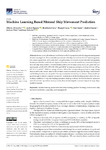Mostrar o rexistro simple do ítem
Machine Learning Based Moored Ship Movement Prediction
| dc.contributor.author | Alvarellos, Alberto | |
| dc.contributor.author | Figuero, A. | |
| dc.contributor.author | Carro Fidalgo, Humberto | |
| dc.contributor.author | Costas Gómez, Raquel | |
| dc.contributor.author | Sande, José | |
| dc.contributor.author | Guerra, Andrés | |
| dc.contributor.author | Peña González, Enrique | |
| dc.contributor.author | Rabuñal, Juan R. | |
| dc.date.accessioned | 2021-10-13T18:57:12Z | |
| dc.date.available | 2021-10-13T18:57:12Z | |
| dc.date.issued | 2021 | |
| dc.identifier.citation | Alvarellos, A.; Figuero, A.; Carro, H.; Costas, R.; Sande, J.; Guerra, A.; Peña, E.; Rabuñal, J. Machine Learning Based Moored Ship Movement Prediction. J. Mar. Sci. Eng. 2021, 9, 800. https://doi.org/10.3390/jmse9080800 | es_ES |
| dc.identifier.uri | http://hdl.handle.net/2183/28615 | |
| dc.description.abstract | [Abstract] Several port authorities are involved in the R+D+i projects for developing port management decision-making tools. We recorded the movements of 46 ships in the Outer Port of Punta Langosteira (A Coruña, Spain) from 2015 until 2020. Using this data, we created neural networks and gradient boosting models that predict the six degrees of freedom of a moored vessel from ocean-meteorological data and ship characteristics. The best models achieve, for the surge, sway, heave, roll, pitch and yaw movements, a 0.99, 0.99, 0.95, 0.99, 0.98 and 0.98 R2 in training and have a 0.10 m, 0.11 m, 0.09 m, 0.9°, 0.11° and 0.15° RMSE in testing, all below 10% of the corresponding movement range. Using these models with forecast data for the weather conditions and sea state and the ship characteristics and berthing location, we can predict the ship movements several days in advance. These results are good enough to reliably compare the models’ predictions with the limiting motion criteria for safe working conditions of ship (un) loading operations, helping us decide the best location for operation and when to stop operations more precisely, thus minimizing the economic impact of cargo ships unable to operate. | es_ES |
| dc.description.sponsorship | This research was funded by the Spanish Ministry of Economy, Industry, and Competitiveness, R&D National Plan, within the project BIA2017-86738-R, the FPI predoctoral grant from the Spanish Ministry of Science, Innovation, and Universities (PRE2018-083777) and the Spanish Ministry of Science and Innovation, Retos Call, within the project PID2020-112794RB-I00. | es_ES |
| dc.language.iso | eng | es_ES |
| dc.publisher | MDPI | es_ES |
| dc.relation | info:eu-repo/grantAgreement/AEI/Plan Estatal de Investigación Científica y Técnica y de Innovación 2017-2020/BIA2017-86738-R/ES/SISTEMA PARA LA OPTIMIZACION DE LA OPERATIVIDAD PORTUARIA MEDIANTE EL ANALISIS DINAMICO DE BUQUE AMARRADO Y CLIMA MARITIMO, CON TRABAJO DE CAMPO Y ENSAYOS EN MODELO FISICO | |
| dc.relation | info:eu-repo/grantAgreement/AEI/Plan Estatal de Investigación Científica y Técnica y de Innovación 2017-2020/PRE2018-083777/ES/ | |
| dc.relation | info:eu-repo/grantAgreement/AEI/Plan Estatal de Investigación Científica y Técnica y de Innovación 2017-2020/PID2020-112794RB-I00/ES/ | |
| dc.relation.uri | https://doi.org/10.3390/jmse9080800 | es_ES |
| dc.rights | Atribución 4.0 Internacional | es_ES |
| dc.rights.uri | http://creativecommons.org/licenses/by/4.0/ | * |
| dc.subject | Machine learning | es_ES |
| dc.subject | Neural networks | es_ES |
| dc.subject | Deep learning | es_ES |
| dc.subject | Gradient boosting | es_ES |
| dc.subject | Decision trees | es_ES |
| dc.subject | Ship movement prediction | es_ES |
| dc.subject | Cargo ship | es_ES |
| dc.subject | Port management | es_ES |
| dc.title | Machine Learning Based Moored Ship Movement Prediction | es_ES |
| dc.type | info:eu-repo/semantics/article | es_ES |
| dc.rights.access | info:eu-repo/semantics/openAccess | es_ES |
| UDC.journalTitle | Journal of Marine Science and Engineering | es_ES |
| UDC.volume | 9 | es_ES |
| UDC.issue | 8 | es_ES |
| UDC.startPage | 800 | es_ES |
| dc.identifier.doi | 10.3390/jmse9080800 |
Ficheiros no ítem
Este ítem aparece na(s) seguinte(s) colección(s)
-
GI-ISLA-Artigos [16]
-
CITEEC-GEAMA - Artigos [88]






